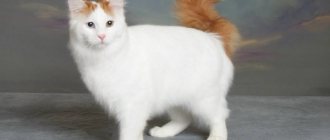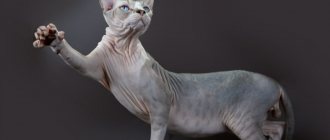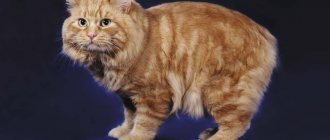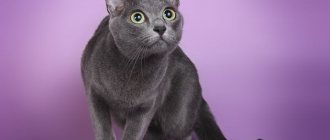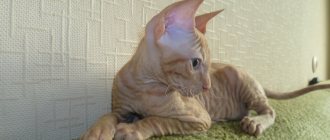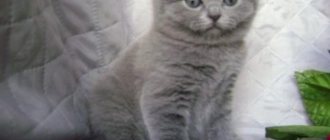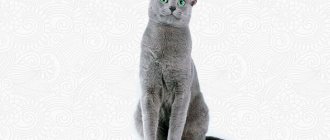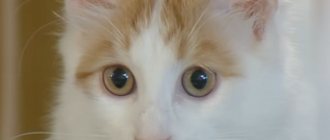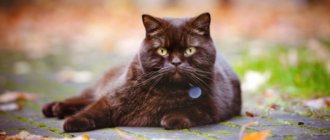Brief history of the breed
Türkiye, or more precisely Eastern Anatolia, is considered the homeland of Van cats. Although they have existed since the Middle Ages, the world felinological community learned about them only in the 50s of the last century. In 1955, English correspondent Laura Lushington and photographer Sonia Halliday saw white shaggy cats with fiery red spots on their heads and tails in Turkey. The girls liked the unusual animals, and local residents gave them a couple of kittens.
On the way to the airport, the engine of the English women's car overheated, and they were forced to stop. When Laura and Sonya went down to the stream, they were surprised to see that the kittens not only followed them, but also began to swim in the water.
Upon returning to their homeland, the girls registered their pets as Van Atilla and Van Guzelli Iskenderun. It was with them that the breeding of the Turkish Van cat in Europe began. In 1979, the breed received official recognition from TICA. And in 1994, the Turkish van was registered by the CFA.
All white van kedisi
Main article: Deafness of white cats
Van-kedisi kitten
According to the Van Qedisi Research Center, among the odd-eyed and blue-eyed all-white Van Qedisi, 2-3% are deaf[48]. The genetic causes of deafness in white cats are quite well studied. The dominant allele of the white skin color gene W- activates certain processes that occur in the early stages of embryo development: the W mutation leads to an almost complete suppression of the migratory ability of melanoblasts. If, at the moment of determination, the process of migration of melanoblasts from the neural tube to their destinations in the epidermis, that is, to differentiating hair follicles, is interrupted at the very beginning, which happens, for example, in cats under the influence of the homo- (WW) and heterozygous (W-) gene W , then melanoblasts do not reach the hair follicles, the proliferation process is disrupted, and completely white animals, such as cats, are born[49]. One of the effects of the white color gene W- on the cat’s body is degeneration of the inner ear[50]. Other side effects of exposure to the W gene include decreased fertility and viability of WW homozygotes.
In contrast to the dominant mutation (symbol W), the semi-dominant mutation of white spotting (Piebald Spotting) (symbol S) moderately reduces the migration speed, therefore, among purebred Turkish Van cats of the Van color there are no deaf cats[15]
complain
Interesting Facts
Over the entire existence of the Turkish Van, many interesting things have been associated with this breed of cats:
- The image of these animals often appears in art. Thus, the Armenian classic Raffi described Van cats in his novels “Sparks” and “Diary of a Cross Thief.” And the famous playwright and writer Vrtanes Papazyan dedicated a short story “Vana Kata” to them.
- In Turkey there is a beautiful legend about Van cats. According to it, a mouse was launched onto Noah's Ark and was given the task of making a hole in the bottom. Fortunately, there was a white cat there, which caught the rodent. In gratitude for his help, God touched the animal, and red spots remained on its body. The Turks call these cats o, and the cats themselves are valued and protected.
- In their homeland, representatives of the breed are called “vana katu”, which translated from Turkish means “cat from Lake Van”.
So what is a Van cat like?
Read part 1. History of the Van cat Van cat, owner. Arushanyan Z.L. Here I would like to remind you that the eye color of white cats and cats with a large amount of white in color can be, firstly, normal, that is, the iris can contain the eumelanin pigment with varying degrees of manifestation, from green to brown, although in most breeding breeds Yellow-orange eyes are welcome. The peculiarity of the white color is that the white color gene is one of the strongest in domestic cats in its effect not only on blocking the formation of pigment in the hair follicles, but also on the development of the rudiments of the nervous system even in the embryonic period. Under its influence, changes in the organs of vision and hearing may occur. Secondly, one of the manifestations of the white gene is the appearance of blue eyes in such cats, which is only possible if there is no pigment in the iris. It can be bilateral (both eyes are blue) or unilateral (one eye is blue and the other is orange) blue-eyedness. Sometimes hearing loss is observed on the side of the blue eye. Kittens for sale Cat nurseries Cat food Atlas of cat breeds
There is no clear relationship between these signs. According to the director of the Ankara Zoo, 5-10% of blue-eyed white cats can hear perfectly, and 25-30% of white cats with intensely colored orange eyes may be deaf. In Van and Anatolian (short-haired Van) cats, under the influence of one of the alleles (piebald or white spotting), named after the cats from Lake Van - the van pattern gene Sv, all that remains of the color are only colored spots on the head between the ears with an obligatory white blaze from the back of the head to the forehead (although the cat’s forehead is just a figure of speech) and a tail painted in the same color. Only tortoiseshell baths are allowed to have spots of a different color in these areas. Other alleles of the white spotting gene that create colors with less white: bicolors and particolors - when no more than half is white, and all the whiteness mainly falls on the lower part of the body - the belly and paws, or when only white gloves and socks remain from the white part, Like the Snowshoe and the sacred Burmese cat, Van cats may be a sign of crosses with cats from other regions. In exhibition examination and breeding of Van cats, only absolutely correct spots on the head and a colored tail are recognized. Individual colored spots on the body are allowed, especially on the left shoulder. All other colors in cats of this breed only indicate that the real selection of this breed is still ahead and depends entirely on enthusiasts. Removing bicolor and harlequin cats from the Van population is necessary to consolidate the originality and uniformity of the gene pool. Discordance, or otherwise heterochromia, of pure white cats, which are bred by the Van Cat Research Center, and cats living freely on Lake Van, and discordance of purebred Vans is formed in different ways. The heterogeneity of all-white cats, including “van-kedisi”, is formed under the influence of the dominant and dangerous gene W - White, which in its homozygous form is considered lethal, that is, leading to the death of those kittens that received it, even in the prenatal period. All completely white cats born into the world can only be heterozygous, that is, in pair with the gene for white color, which deprives the coat of any pigment, “non-white” is necessarily attached, due to which colored ones are necessarily born in litters from white parents (for example , completely black) kittens. The heterogeneity of Van color cats is formed under the influence of the white spotting gene, which preserves small spots of colored fur with strict localization, and is less harmful to the body as a whole. There are practically no deaf cats among Van cats, and even in the homozygous state, this gene does not cause the death of half the litter even before birth. Therefore, it is possible to maintain the Vanir breed without infusing them with the blood of pure white cats or some others. When bred “purely”, they will retain viability and uniformity of color, which will make it possible over time to obtain a population of cats of this breed that is absolutely homogeneous in color. The breed is created not so much by color as by some other constitutional features. Equally white Persians and Turkish Angoras will differ in the massiveness and bonyness of the body, its width and length, the shape of the head and the features of the muzzle in front and profile. The Angora or Angora-Kedisi, as it is called in Turkey, differs from the Vans not so much in the color of its coat and eyes, but in its greater elegance and long, flowing coat. Vans have stronger, denser muscles and, according to the WCF standard, have a more visible undercoat. Completely white Van Kedisi have no color markings, but otherwise have the usual body type for Vans and should only be bred with colored Vans to avoid the manifestation of the negative properties of the white dominant color gene - W during white-on-white breeding, which is prohibited in Europe. Breeding pure white cats “inside” can lead to a sharp reduction in cats of this color, precisely because of the action of the lethal W gene in the homozygous version. In 1987, the Van Cat Research Center was established at the University of Van, which breeds only cats of this breed. At the same time, in Turkey there is not a single felinological club or nursery that is part of any international organization, which would make it possible to determine the breed standard and conduct breeding work using the achievements and knowledge of modern cat genetics. In addition, a modern purebred cat is not only its appearance, but also certain behavioral qualities aimed at close communication with humans, which are also achieved only as a result of long-term selection. The domestic cat differs from wild species in that it needs to communicate with humans. Domestication is a long process, and any alienation of domestic cats from humans and their separation into a semi-wild community leads to a loss of sociability and accumulation of aggressiveness towards humans. The active avoidance of humans characteristic of wild cats, imposed by living conditions on a domesticated species, will create additional problems when returning them “to the family.” But, most importantly, this will not create a new breed and will not preserve the old one. The breed of any animal is a man-made work of selection art, taste and luck of the breeder. And nature creates species of animals that we humans, according to statistics, are diligently losing and destroying. Living in a semi-wild state in villages and even in houses specially built for them, isolated from human habitation on the shores of Lake Van, cats can only be used as breeding material to expand the gene pool of purebred Van cats, the origin of which is recorded in pedigrees numbering from 4 to 10 tribes of ancestors. Turks love to tell what they call a “Turkish” legend that explains the appearance of copper-chestnut spots on the Van cat’s coat. According to this legend, Allah blessed the white Van cat by placing his hand on it as it emerged from Noah’s Ark, which landed on land, which turned out to be Mount Ararat, located in what is now Turkey a couple of kilometers from the border with modern Armenia. In those places on the skin where the Lord God touched it, flaming spots appeared. The imprint on the left shoulder, which is similar in shape to the imprint of a human finger, is called by the Turks the mark of the “finger of the right hand of Allah.” How does this spot resemble a fingerprint? In its center there is a lighter spot, as if the paint had been pressed onto the periphery with a finger. This happened because in ordinary cat breeds “there is no red without a tabby,” and even in the absence of the A gene - Agouti, which ensures striped fur in cats of other colors, there are always lightenings and stripes on the red spots of Vans. It is a pity that this legend is contradicted by the Van Kedisi “selection” carried out in Turkey, when all colored cats are rejected, except for completely white cats with different eyes. Along with them, cats that bear traces of the “blessing of Allah” on their skin are also destroyed. Van cat, ow. Arushanyan Z.L. Interest in the Van cat can also be evidenced by the fact that on March 29, 2007, at the World Cat Congress in Dortmund, Van Allwhite Vans, or pure white cats from joint breeding with traditional cats, were presented for recognition as a full-fledged color variety of cats of the breed Vanami. On the one hand, this seems to expand the very limited breed pool, on the other hand, it introduces problems into the examination of cats at the exhibition, since all-white Vans have very minor external differences with the aboriginal cat of the neighboring state - with the white Siberian cat, which is constitutionally almost no different, and the amount of undercoat, which a Siberian should have a lot of, is a seasonal concept and cannot be taken as a clear breed-forming characteristic. We are not going to make genetic testing mandatory at cat shows, so as not to mislead the judges. Maybe ban white Siberians altogether? I’m not sure that lovers of Siberian cats will support such a proposal. When creating a new breed, and even more so registering it, they strive to create a completely new exterior with characteristic external differences. In this case, they use certain methods, conduct breeding work from a common ancestor, select pairs, register the results obtained in stud books and pedigrees, etc. If a new breed or breed group does not have characteristic features and repeats the features of another breed, members of the commission in registration is refused, which indicates that the work to create a new breed is still far from being completed. We respect the cultural and religious traditions of all peoples. At the same time, we would like our traditions to be respected. This applies equally to both the Siberian and Van cats. And the fact that the Van cat originally had a colored tail and was not completely white is confirmed even by the few evidence that has survived to this day. For example, large light cats with characteristic ring-shaped tails are depicted on jewelry from the period of Urartu or the Kingdom of Ararat, dating from the 2nd - 1st centuries. V. BC e. or on edged weapons from the time of Roman rule, dating from the 1st - 3rd centuries. V. n. e. Moreover, in the legend they retell about how fiery red marks appeared on a Van cat, the Turks do not provide a convincing explanation for why the Creator blessed the cat. The Turkish version of the legend only confirms the existence in ancient times, even in the era of early paganism, on the shores of Lake Van of a certain cult that revered the red and white Van cat. If we take into account that the long-term residence of ethnic groups other than Armenians in the Armenian Highlands began in the last 5-6 centuries, i.e. much later than the above-mentioned images of cats appeared, it becomes clear that the legend, as well as the breed itself, went to Turks are “inherited” from another ethnic group. Since cats are particularly fertile, most likely, like other Indo-European peoples, the veneration of cats among Armenians in the era of paganism should have been related to the cult of the mother goddess. It is also known that in the village of Artamet, which once existed on the banks of the Van, which later became a suburb of the city of Van, there was a temple of the pagan goddess Astghik, who in ancient times was revered as the mother goddess. Unfortunately, evidence for this assumption has yet to be found. The answer to the question of why, according to the legend retold above, the Lord God blessed the cat by touching its forehead with his fingers and stroking its back, we were able to find in the same place where the legend about Noah and the tasting of the first post-Flood wine is given. It turns out that the Lord God created the cat specifically so that it would destroy the mouse, which tried to gnaw a hole in the bottom of the Ark in order to sink it. Which is what the cat did, and thereby saved Noah’s family, and therefore all of humanity, and you and me. This is how she is - the cat from Lake Van, or in Armenian simply “vana-katu”, the heroine of legends of different nations.
Zarine Lorentsovna Arushanyan
The author expresses gratitude to Olga Sergeevna Mironova for her assistance in writing the article
Cats
Catalog of cat breeds with descriptions and photographs
Turkish Van cat breed
So what is a Van cat like?
Breed description, standards, appearance
Van cats are athletic, harmoniously built animals with developed muscles and a bushy tail. A detailed description of the Turkish Van breed is presented in the official standard, which was adopted by the international felinological community in 1994.
Dimensions and weight
Representatives of the breed are quite large in size. The length of their body together with the tail is about 0.9-1.3 m with a height of up to 40 cm at the withers.
An adult Van cat weighs about 9-10 kg. The cat's weight reaches 5-6 kg.
Anatomical characteristics
A typical Turkish van should fit the following description:
- The head is wedge-shaped, with a neat, rounded muzzle, a smooth profile, developed cheekbones and a strong chin.
- The ears are large, set far back, with a wide base and a straight outer edge.
- The eyes are large and oval. Planted at a barely noticeable angle, slightly elongated towards the corners. The iris of Turkish Vans can be blue, amber or copper. The breed often contains cats with heterochromia.
- The body is strong, elongated, with developed muscles, broad shoulders, a round chest and a short muscular neck. No angularities or straight lines.
- The limbs are strong, of medium length, with neat round paws, pink pads and tufts of hair in the interdigital space. The hind legs of the Van cat are slightly shorter than the front ones.
- The tail is of medium length, with good feathering. Visually resembles a brush or train.
Color and coat type
Van cats are semi-long-haired animals without a pronounced down. The shoulders of Turkish Vans are covered with shorter fur. On the tail and back of the body of representatives of the breed, the hair is noticeably longer.
Most Turkish cats have the classic Van coloring. Such animals should have a snow-white body, a chestnut-red tail, and red markings on the muzzle and at the base of the ears.
Color genetics including white
Since the trait of this species is dominant, offspring with white color can only appear if the father or mother (preferably both) have white spots. If only one parent is the carrier, there is a high probability of giving birth to a mitted kitten (mit gene). At the birth of a baby, colored spots on the fur are already present and as they grow older they become brighter, and their boundaries become sharper.
In the genetic classification, the gene for white spots is S, the gene for the absence of these spots is s.
In combination it turns out:
- SS (homozygous) is a characteristic of a carrier of dominant heredity. Such a parent produces exclusively kittens with snow-white spots;
- Ss (heterozygous) is a characteristic of a carrier of two types of heredity: plain and white. In a pair of two parents having this gene, there is a possibility of offspring with and without white spots;
- ss (homozygous) is a characteristic of a cat without the necessary heredity at all. A father and mother with such a set of genes never produce offspring with white spots.
Photo - British shorthair kittens chocolate tortoise bicolor
Scottish Straight Red Spotted Tabby Bicolor – SFS 71 d 24 03
Subspecies of colors with white spots:
- Bicolor (SS or Ss gene) – two thirds of the coat is colored, the rest is white;
- Harlequin (Sp gene) – the colored fur area is no more than one sixth (on the tail, hind legs and head);
- Van (gene Sv) – almost completely snow-white, only the tail is colored.
The gl gene is recessive and is responsible for the color of the limbs.
The Oa gene is dominant and can produce snow-white patches on the cat’s body, subject to the obligatory condition of the blue color of the cornea.
British cat BRI n 03 62
Cinnamon red with white bicolor – q 03
Character and temperament
The Turkish Van is a gentle and friendly cat that quickly becomes attached to people. She is very emotional and sensitive to the mood of her owners. The Van cat unmistakably senses the beginning of a conflict and tries to extinguish it like a real peacemaker.
The patient and friendly animal gets along well with children and enjoys playing with them. It should be remembered that the Van cat does not like to be squeezed and stroked against its will. Therefore, she can scratch and even bite an overly annoying child.
The Turkish Van easily gets along with other cats and dogs. But it’s better not to introduce him to fish, birds, reptiles and rodents.
How to choose the right kitten
Buying a Turkish Van is complicated by the fact that it is a fairly rare breed. The few nurseries specializing in breeding these cats are concentrated in Europe and America. And in the homeland of the Van, there are restrictions on the export of breeding individuals outside of Turkey.
Important! To avoid becoming a victim of scammers, you should only buy a Turkish Van kitten from a reputable nursery and draw up an agreement. Together with the baby, the owner must receive documents that display information about his ancestors and vaccinations.
The Van kitten is easy to distinguish by its unique coloring and coat quality. And his health can be indirectly judged by his good appetite, active behavior, clean ears and soft belly.
Kitten care
Not a single reputable nursery will hand over a Van kitten into the hands of its owners before it turns 12 weeks old. By this age, Turkish children are already fully socialized and adapted to independent living.
Typically, three-month-old Van kittens already know how to use a tray and a scratching post. This means that new owners will not have to teach their pet basic skills. You just need to give the kitten the opportunity to get acquainted with the new home and set the limits of what is permitted.
Important! To prevent the Van kitten from being injured, wires, breakable objects, detergents and flowerpots with ornamental plants are hidden in the house in advance. Also, for safety reasons, the animal is restricted from accessing large household appliances, open balconies and open windows.
Diseases
Since the Turkish Van is an aboriginal breed, they have fewer genetic pathologies than hybrid breeds. However, health problems still arise. Let's list the main ones:
Hypertrophic cardiomyopathy is an insidious disease that, unfortunately, cannot be completely cured, but can be “suppressed” and alleviate the pet’s general condition. It is expressed in thickening of the left cardiac ventricle and the septum between the ventricles (while the ventricular cavity itself is greatly reduced).
The disease occurs more often in males: the animal becomes more lethargic, suffers from shortness of breath, tachycardia, breathes heavily, and a murmur is heard in its heart. Pulmonary edema gradually increases, fluid accumulates in them, pressure increases, and partial paralysis occurs. The cough is completely absent. Catalyst: prolonged stress, illness, infusion therapy carried out without proper calculations of the speed and volume of fluid. Treatment is medication; in severe cases, it occurs in a hospital.
The weakest point of the Turkish Van is the gums and teeth. The gums often become inflamed, and tartar builds up on the teeth. Other diseases also appear. Therefore, it is important for you to monitor this from the very beginning: choose the right care products, brush your teeth regularly, and regularly take your animal for examination to the veterinarian.
Expert opinion
Dusheba Vera Ivanovna
In 2010, she graduated from the Moscow State Academy of Veterinary Medicine named after K.I. Scriabin with honors, specializing in veterinary medicine. I regularly attend veterinary conferences, congresses, and webinars.
Do not refuse vaccination, even if your cat is indoors and, in your opinion, is completely protected. This is not true: pathogens of such dangerous diseases as panleukopenia, rhinotracheitis and others easily enter your home on clothes or hands.
Care and maintenance
The Turkish Van must be protected from drafts, cold and dampness. Otherwise, caring for a representative of the breed differs little from that for any other semi-long-haired domestic cat.
Hygiene procedures
In order for the Turkish van to have a neat appearance, it is provided with appropriate care:
- To prevent tartar and other dental problems, cat teeth are brushed with a soft silicone brush with a small amount of non-foaming paste. The procedure is carried out 2-3 times a week.
- The ears of the Turkish Van are periodically cleaned from accumulated dust and dirt. To do this, a special product is instilled into each of them and after a few minutes they are wiped with a moistened cotton pad.
- The eyes of a Van cat are treated daily with a piece of natural fabric moistened with a herbal decoction or boiled water.
- The claws of the Turkish Van are shortened with a nail clipper as they grow. Only the transparent ends can be cut off.
Grooming
The fur of the Turkish Van does not tangle and is easy to comb with a comb. In normal times, it is enough to do this 2 times a week. During the molting period, the Van cat is scratched daily.
Representatives of the breed are bathed no more than 3-4 times a year. To do this, the water-repellent coat of the Van cat is thoroughly moistened, lathered with mild shampoo and rinsed thoroughly. At the final stage, the animal is wiped with a terry towel.
Tray
A Turkish bath needs a spacious tray with high sides. The type of litter depends on the individual preferences of the cat. The only thing that experienced breeders do not recommend using is wood shavings, particles of which stick to the tail and paws of the animal and are spread throughout the house.
On a note. The Van cat is very clean and will not go into a dirty litter box. Therefore, it is advisable to install a spare toilet for her.
Breeding work
Like all large cats, the Turkish Van matures slowly - the animal is fully formed only by the age of three, or even five years. Therefore, you should not be too hasty with mating, especially in cats: early motherhood can negatively affect the health and psyche of an immature animal.
Interestingly, kittens of this breed, on the contrary, develop very quickly - they, for example, open their eyes already on the third day of their life!
Obtaining high-quality offspring is the main task of breeding work
Breeding
The gene pool of Turkish Vans in Europe is extremely small, and the choice of a partner can often depend on closely related ties. Therefore, to obtain high-quality offspring, the most important issue is the correct selection of a breeding pair - however, as always in breeding. A newbie divorcer is often unable to solve this problem on his own. Rely on the experience and knowledge of your breeder, who cares about the prospects of the breed and will be able to advise you on the best options.
As far as possible, trace the heredity along both parental lines - find out if there were any serious defects or genetic diseases in them:
- deafness in white cats;
- curvature of the jaw;
- creases and kinks in the tail;
- color marriage.
Producers must reach reproductive age (at least two years), be absolutely healthy and prepared for mating: have timely vaccinations and antiparasitic treatment.
Breeding success begins with the proper selection of parent pairs
The physiology of a cat allows it to become pregnant and give birth three or even four times a year. But in practice, this cannot be allowed - the cat must be able to fully recover during the period between births, and this requires time. The optimal frequency of effective matings is three times in two years.
Sterilization issues
If the Turkish Van will not be used for breeding, then it is better to sterilize such an animal - both male and female. Removing the genitals will help solve several serious problems at once:
- normalize hormonal levels;
- reduce the level of aggression and excessive activity;
- avoid possible cancer and genital diseases.
Before sterilization, the cat must undergo a medical examination
Often, when selling a pet-class kitten, breeders make its subsequent sterilization a mandatory condition - individuals that do not meet the high requirements of the breed standard should not participate in breeding, thereby reducing the overall quality of the Turkish Van population.
But it should be remembered that sterilization is by no means a harmless manipulation, but an operation (for a cat - abdominal), which takes place under general anesthesia. Therefore, it is extremely important that sterilization of the animal is carried out by experienced specialists and not at home, but in a veterinary clinic. Veterinarians will take control of the Van’s rehabilitation after surgery, which is no less important than a successful operation.
A feature of sterilization of the Turkish Van is the late maturation of representatives of this breed, which must be taken into account when determining the optimal timing of the operation. If cats and cats of other domestic breeds are usually sterilized immediately after puberty, then Vans should wait a bit in this matter - otherwise the animal will stop growing and developing. It is customary to sterilize female Van breeds at the age of one and a half years, and males - no earlier than a year.
Video: how to care for a cat after sterilization
Feeding the cat
To maintain good health and physical activity, the Turkish Van needs a balanced diet enriched with protein. Cats of this breed eat both commercial and natural food well. Therefore, the right of choice remains with the owner.
Complete diet
With an industrial type of nutrition, the Van cat is given premium or super-premium drying, which contains the entire range of minerals and vitamins. When choosing food, it is important to pay attention that it does not contain soy, corn, wheat, dyes and other additives of little use. Products from the following brands are best suited for a Turkish van:
- Royal Canin;
- Arden Grange;
- Pro Plan;
- Pronature;
- Hills.
With a natural type of nutrition, fresh, lean meat should predominate in the Van cat’s diet. She is also given cereals, eggs, vegetables, offal, ocean fish and dairy products.
To keep the Turkish Van healthy longer, pork, bones, sweets and sausages are excluded from his menu. Also, the animal is not given river fish, baked goods, starchy vegetables, whole milk and any food from the owner’s table.
Feeding frequency
When drawing up a feeding schedule, it should be taken into account that Turkish Van kittens eat less, but more often than adult representatives of the breed:
- up to 3 months – 5-6 times a day;
- 3-5 months – 4 times a day;
- 5-12 months – 3 times a day.
A one-year-old Turkish Van is being given two meals a day.
Vitamins and minerals
Van cats that eat natural food may lack nutrients. To compensate for the deficiency of vitamins and minerals, they are given special supplements twice a year.
Important! An excess of microelements is just as dangerous as a deficiency. Therefore, before introducing vitamin-mineral complexes into the Turkish Van’s diet, the cat is shown to a veterinarian.
Catering
Natural products
Natural food is good because you can always buy fresh food and, from time to time, pamper your pet with new cereals or cutlets.
From natural products it is allowed to give:
- lean boneless meat (beef, veal, chicken, lamb and turkey);
- fish (flounder, trout, salmon, navaga);
- fermented milk products (cottage cheese, yogurt, sour cream, cream, fermented baked milk, natural yogurt);
- porridge (rice, millet, semolina, buckwheat, oatmeal);
- stewed or boiled vegetables (pumpkin, zucchini, carrots, asparagus, broccoli, cucumbers);
- fruits (melon, apple, pear, watermelon).
You should not feed your Turkish Van food that is fatty, fried, smoked, salty or sweet. Seasonings, pickled vegetables, flour, baked goods, many vegetables (potatoes, tomatoes, peas, eggplants) and fruits are prohibited!
Recommended food
Breeders from the USA and Canada strongly recommend feeding Vans with high-quality ready-made food. These include holistic and super-premium food. These are expensive, but high-quality feeds made from high quality products.
Contains: dehydrated meat and fish, dried berries, fruits and vegetables, a good vitamin and mineral complex has been added. Examples of holistic foods: Nutram, Carnilove, Farmina N&D. Super-premium food: ProSeries, Fitmin For Life.
Economy food classes: Whiskas, Nasha Marka, TerraKot and premium are lower in quality and are not worth buying without unnecessary need.
Below are recommended super-premium foods. Links with the names of the food are clickable, on them you can, within our website, get acquainted with the descriptions of the food and read reviews from owners of Turkish Van cats.
| Holistic | Super premium | Super premium |
| Primordial | Guabi Natural | 1st Choice |
Turkish Vans are prone to obesity, so do not overfeed the animal and do not teach it to snack between meals.
You can only drink clean filtered water. It can be settled, bought distilled, or purified using a kitchen filter.
Education and physical activity
Van cats are active and temperamental animals. They love to run, jump and walk. In the warm season, it is advisable to regularly take them out into the yard. And to maintain physical fitness at home, they will be equipped with a “sports” corner with multi-level shelves and ladders.
On a note. The Turkish Van is not afraid of water and loves to splash around in it. Therefore, in the summer, you can equip your cat with a small pool where she can swim.
The Turkish Van is a highly intelligent and intelligent animal that is easy to train. A cat of this breed gets used to the litter box without any problems and quickly remembers the rules of behavior in the house.
Character of the Turkish Van
A real Turkish van kedisi is a cat, designed for close interaction with the owner and energetic entertainment. Neither his impressive size nor your dissatisfied glances will prevent your cat from flying around the apartment after a rolling ball or methodically torturing a crumpled newspaper. Moreover, this comrade will go out of his way to seduce the owner into playing together or, at a minimum, throwing rubber squeakers - the breed loves to fetch objects. From time to time, a climber awakens in every animal, forcing him to remember that there are unconquered peaks in the house, such as a closet, a refrigerator and a chest of drawers. Not to say that Turkish Van cats are such supermen, famously taking any height, but they climb household appliances and furniture quite cheerfully.
If you want to look at a “hung” cat, open the water in his presence. Any flow of life-giving moisture acts on a pet like a magnet, from which the animal can only be torn off by turning off the tap. For those who like to shoot funny videos in their own bathroom, we can recommend letting a van in there, who will certainly make a “big splash”, relax heartily in the warm water and try to catch the stream. It’s the same story with country ponds and fountains, so if you breed fish in them, keep an eye on them. The Turkish-Armenian ancestors of Van cats were engaged in fishing at a professional level, and their domesticated descendants continue to “fish” in decorative ponds and indoor aquariums.
Turkish Vans like to keep the situation under control, so they almost always hang around people. At the same time, they do not suffer from obsession and dependence on their master’s attention. Yes, the furry sly guy is reluctant to play alone and prefers group entertainment, but it’s not in his rules to bother him with demands. Often, a pet’s behavior is determined by its gender. Cats, for example, are born managers and leaders who tremble over their own independence. Cats are more relaxed and positive, happily letting their partners take the wheel.
For the Turkish Van, a person is not an absolute authority, but an equal playmate and a pleasant pastime. Don't expect the furry nobleman to lie sleepily on your hands and knees. To equalize his authority with that of his master, the van will certainly climb onto your back or shoulders and from above will cast a contemptuous glance at those around you. By the way, about looks and facial expressions: the pet’s emotions are reflected not only in behavior, but also in the expression of its face, so if the cat is dissatisfied with something, the owner will be the first to know about it. In addition, a Turkish Van living in a family will definitely single out a favorite, with whom he will build a special line of behavior. The privileges that the cat's trusted representative will receive are a gentle purr in response to momentary stroking (not to be confused with squeezing) and an immediate reaction to the affectionate “kitty-kitty-kitty.”
Vaccinations and antiparasitic treatment
To prevent infectious and viral diseases, the Turkish Van is subject to routine vaccination. At the age of 7-8 weeks, the kitten is vaccinated with a complex drug that activates the development of stable immunity to rhinotracheitis, calcivirosis and panleukopenia.
After 28 days he is vaccinated against the same diseases and against rabies. In the future, a cat of this breed is vaccinated once a year.
To prevent infection with diseases carried by parasites, the Turkish Van is systematically treated for fleas and worms. Anthelmintic drugs are given to the cat twice a year with mandatory repetition after 10-14 days.
To combat fleas, the Turkish Van is treated with special drops or shampoos. And if the cat is outside, an anti-parasitic collar is put on it.
Health of the breed
Native cats, which include Vans, usually do not have a tendency to hereditary diseases. One of the weakest points is the teeth and gums. Stone forms more actively on them, gum disease occurs more often, which causes discomfort and pain to the cat. Despite the fact that they are active animals, they are nevertheless prone to gaining weight. In this case, it is important to follow a special diet.
Tendency to diseases
The Turkish Van cat may be more likely to encounter a number of diseases:
- cardiac hypertrophic cardiomyopathy;
- various types of allergies;
- hormonal imbalances;
- urolithiasis disease;
- some heart pathologies.
The average lifespan is about 15 years.
Vaccinations and prevention
The first vaccinations are given to kittens when they are still with the breeder. They are entered in the veterinary passport that they receive at birth. The first vaccination is carried out at the age of 8 weeks. After some time it is necessary to do this again. When the animal reaches its owner, vaccination is carried out according to the requirements of the veterinarian.
The animal must have all the required vaccinations, even if it does not go outside and is kept exclusively at home. A strong immune system is not able to protect a cat from a number of infectious diseases, some of which are fatal.
Pros and cons of the breed
The Turkish Van, like a cat of any other breed, has not only advantages, but also disadvantages:
| pros | Minuses |
| Pleasant appearance | Rarity of the breed |
| Easy to care for | High cost of kittens |
| High intelligence |
Van cats are beautiful animals with luxurious semi-long hair of a unique color. They have a playful nature and make excellent companions for those who are willing to give them enough time and attention.
